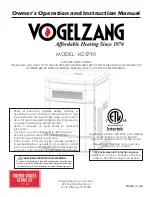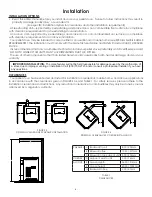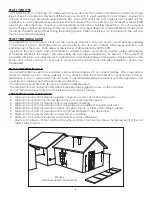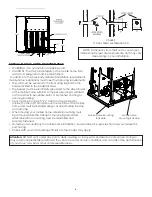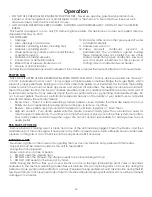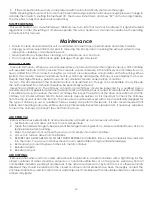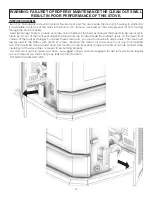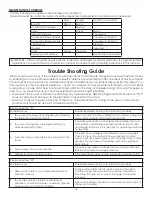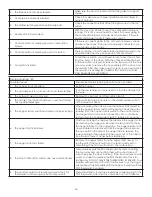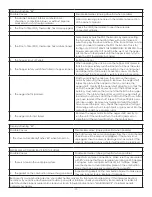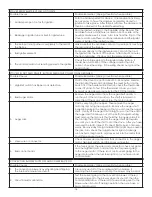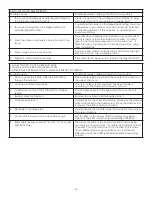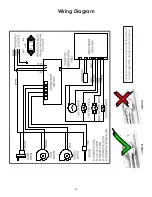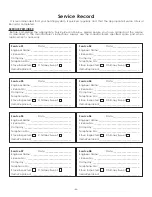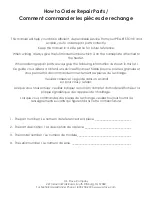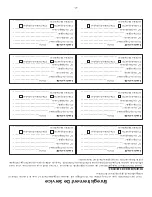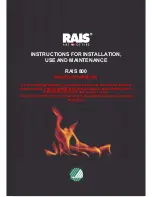
-12-
2.
If the combustion blower fails, an air pressure switch will automatically shut down the auger.
NOTE: Opening the stove door for more than 30 seconds during operation will cause enough pressure change to
activate the air switch, shutting the fuel feed off. The stove will shut down and show “E2” on the two digit display.
The stove has to fully shut down before restarting.
TAMPER WARNING
This wood heater has a manufacturer-set minimum low burn rate that must not be altered. It is against federal
regulations to alter this setting or otherwise operate this wood heater in a manner inconsistent with operating
instructions in this manual.
•
Failure to clean and maintain this unit as indicated can result in poor performance and safety hazards.
•
Unplug your stove’s electrical cord prior to removing the back panel or opening the exhaust system for any
inspection, cleaning, or maintenance work.
• Never perform any inspections, cleaning, or maintenance on a hot stove.
•
Do not operate stove with broken glass, leakage of flue gas may result.
EXHAUST SYSTEM
Creosote Formation – When any wood is burned slowly, it produces tar and other organic vapors, which combine
with expelled moisture to form creosote. The creosote vapors condense in the relatively cool chimney flue or a
newly started fire or from a slow-burning fire. As a result, creosote residue accumulates on the flue lining. When
ignited, this creosote makes an extremely hot fire, which may damage the chimney or even destroy the house.
Despite their high efficiency, pellet stoves can accumulate creosote under certain conditions.
Fly Ash – This accumulates in the horizontal portion of an exhaust run. Though non-combustible, it may impede
the normal exhaust flow. It should, therefore, be periodically removed.
Inspection and Removal – The chimney connector and chimney should be inspected by a qualified person
annually or per ton of pellets to determine if a creosote or fly ash build-up has occurred. If creosote has accumulated,
it should be removed to reduce the risk of a chimney fire. Inspect the system at the stove connection and at the
chimney top. Cooler surfaces tend to build creosote deposits quicker, so it is important to check the chimney
from the top as well as from the bottom. The creosote should be removed with a brush specifically designed for
the type of chimney in use. A qualified chimney sweep can perform this service. It is also recommended that
before each heating season the entire system be professionally inspected, cleaned and, if necessary, repaired.
To clean the chimney, disconnect the vent from the stove.
ASH REMOVAL
Remove the ashes periodically to avoid unnecessary ash build up. Ash removal is as follows:
1. Let fire burn out and allow unit cool to room temperature.
2.
Clean the heat exchanger tubes (see Heat Exchanger Cleaning section) – Make sure Pellet Stove is at room
temperature before touching .
3. Open the ash pan door, remove the burn pot and empty into metal container.
4. Vacuum to remove ashes from the firebox.
5. BE SURE THAT ASHES ARE COOL TO THE TOUCH BEFORE VACUUMING. Some vacuum cleaners may leak ash
into the room. Your vacuum cleaner should have a special filter or bag to eliminate leakage.
6. Remove ash pan and dispose of ashes into metal container.
7. Reinstall ash pan.
8. Reinstall burn pot.
ASH DISPOSAL
Remove ashes when unit has cooled. Ashes should be placed in a metal container with a tight fitting lid. The
closed container of ashes should be placed on a noncombustible floor or on the ground, well away from all
combustible materials, pending final disposal. If the ashes are disposed of by burial in soil or otherwise locally
dispersed, they should be retained in the closed container until all embers have been thoroughly cooled. The
container shall not be used for other trash or waste disposal. If combined with combustible substances, ashes and
embers may ignite.
Maintenance

